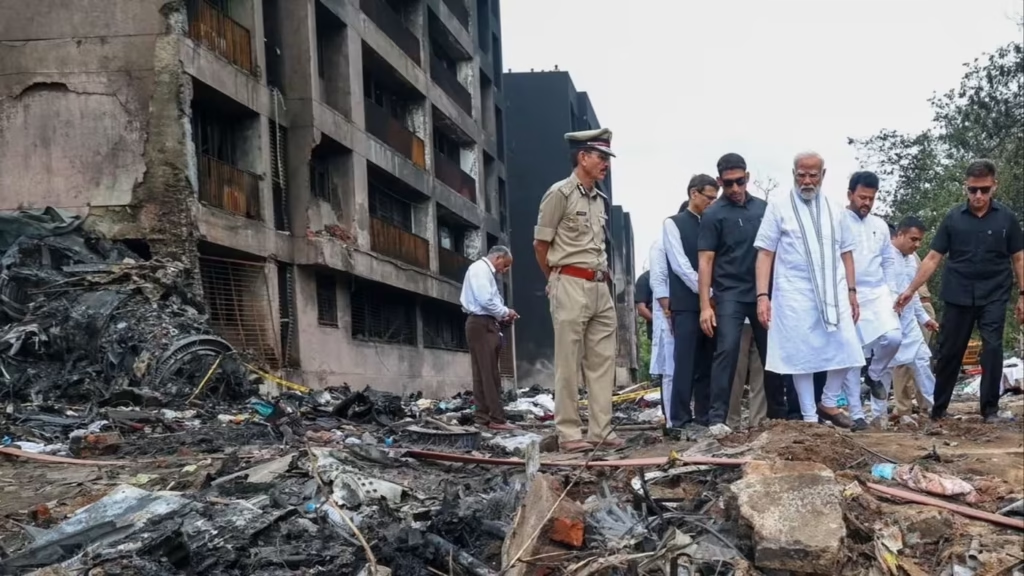The Air India crash in Ahmedabad has raised serious questions about Boeing’s Dreamliner. Here’s a Time-style investigative look at the crash, its causes, and what Boeing must answer.
By the Time It Hit the Ground, Was This Crash Already Written Into the Code?
Ahmedabad. June 12, 2025. The sun was just setting when Air India Flight AI171 lifted off—barely. Within 90 seconds, the Boeing 787‑8 Dreamliner slammed into a residential zone. A city gasped. The world took notice.
- The Air India crash in Ahmedabad has raised serious questions about Boeing’s Dreamliner. Here’s a Time-style investigative look at the crash, its causes, and what Boeing must answer.
- “Mayday, Mayday” — What We Know So Far
- Could It Have Been Prevented? The Checklist of Concerns
- ❓ Engine Thrust: A Fatal Drop
- ❓ Flaps and Gear: Too Much Drag, Not Enough Lift
- ❓ Aging Aircraft, Aging Assumptions
- Is This Boeing’s Second Great Crisis?
- A Storm of Questions — and Silence
- Inside the Investigation
- What If This Is Bigger Than One Plane?
- Where Does Boeing Go From Here?
- ❓Six Big Questions That Need Answers Now
- Final Word: The Dreamliner’s Dream Is on Pause
The aircraft, an 11-year-old Dreamliner, didn’t get far. Its engines, or something deeper in its design, failed to deliver what Boeing once promised: a new age of flight. 241 people died. One survived. And now, Boeing is facing a storm of scrutiny.
This is more than a crash. This is a reckoning.

“Mayday, Mayday” — What We Know So Far
Black box data confirms the jet never cleared 650 feet. It slowed mid-climb, failed to retract its landing gear, and possibly never deployed its flaps—two basic actions that any takeoff depends on. A final “Mayday” was radioed in. But the rest? Silence.
Did thrust fail? Were sensors giving bad data? Or was this a case of automation confusion—where the plane didn’t know what it was doing, and neither did the pilots?
Could It Have Been Prevented? The Checklist of Concerns
❓ Engine Thrust: A Fatal Drop
Radar and telemetry reveal that speed and climb rate dropped almost immediately. Investigators suspect significant loss of engine thrust—a showstopper at that altitude. Was this a GE engine issue? A fuel problem? Or Boeing’s throttle management systems?
❓ Flaps and Gear: Too Much Drag, Not Enough Lift
Footage shows gear down, flaps possibly retracted. That configuration acts like a parachute, not a lifter. If true, either the pilots missed basic steps—or the plane didn’t warn them. What failsafe systems were missing?
❓ Aging Aircraft, Aging Assumptions
This 787‑8 was delivered in 2014. Boeing had insisted on long-life confidence for these jets. But did heat, wear, and fatigue from India’s operating environment outpace Boeing’s maintenance predictions?
Is This Boeing’s Second Great Crisis?
After the 737 MAX disasters, Boeing restructured its safety culture—or claimed to. But now, with a fatal crash involving its other flagship jet, the Dreamliner, déjà vu feels dangerously close. Whistleblowers had warned of 787 production shortcuts in Charleston. Did anyone listen?
Regulators, analysts, and airlines are starting to ask: What else might be wrong?
A Storm of Questions — and Silence
| Key Issue | Unanswered Questions |
|---|---|
| Engine Thrust | Were sensors, software or engines to blame for underpowered takeoff? |
| Flaps/Gear Systems | Why no cockpit warning? Was it human error—or automation failure? |
| CVR (Cockpit Voice Recorder) | What did the pilots say or hear? Why hasn’t it surfaced yet? |
| Flight Safety Monitoring | Why didn’t Boeing push for mandatory 10-year deep inspections globally? |
| Global Oversight | Will FAA, DGCA, or EASA demand re-certifications or updates for 787s? |
Inside the Investigation
India’s Directorate General of Civil Aviation (DGCA) is leading the probe, joined by the U.S. NTSB, UK AAIB, and Boeing itself. The Flight Data Recorder (FDR) was recovered within 48 hours; the Cockpit Voice Recorder (CVR) remains missing.
Boeing insists it’s cooperating fully. But critics say it’s déjà vu: quiet meetings, delayed responses, and guarded language. Sound familiar?
What If This Is Bigger Than One Plane?
With over 1,100 Dreamliners flying worldwide, any systemic flaw could trigger global consequences. Airlines are quietly reassessing checklists. Some are speeding up inspections. A few are calling for fleet reviews.
If final reports point to Boeing’s systems, expect lawsuits, regulatory crackdowns, and potential groundings. Again.
Where Does Boeing Go From Here?
This crash is a gut check—for Boeing and the industry. Trust, once shattered, is hard to rebuild. The MAX crisis nearly broke the company. This Dreamliner disaster could stain its reputation permanently.
Boeing has two options:
- Get ahead—transparently, aggressively, and globally.
- Play defense—and risk being left behind by airlines, regulators, and passengers alike.
The next few weeks may decide the company’s future.
❓Six Big Questions That Need Answers Now
- Did the 787’s engine software or sensors misfire during takeoff?
- Were the flaps and gear failures a pilot oversight—or automation gap?
- Why is the CVR still missing, and what’s being done to recover it?
- What inspection intervals did Boeing recommend for aging Dreamliners?
- Will India, the FAA, or EASA impose new safety mandates?
- Is this the start of another Boeing-wide crisis in credibility?
Final Word: The Dreamliner’s Dream Is on Pause
The Boeing 787 was once a marvel of innovation. Lighter. Smarter. More efficient. But this crash is a brutal reminder: Technology alone doesn’t guarantee safety. Accountability does.
Now the world waits—not just for data, but for action. Boeing’s real test isn’t in courtrooms or boardrooms. It’s in the sky, where passengers still board 787s every day, asking, silently:
Is this jet still safe?









